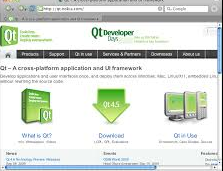Overview
Qt pronounced cute is a cross-platform application framework and toolkit for creating classic and embedded graphical user interfaces, and applications that operate on various software and hardware platforms with small or no alter in the underlying codebase, while still being a local application with local capabilities and speed. Qt is recently being improved both by The Qt Company, a listed company, and the Qt Project under open-source governance, including individual developers and firms working to advance Qt. Qt is available under both commercial licenses and open source. GPL 2.0, GPL 3.0, and LGPL 3.0 licenses. To make Qt-based web applications, Qt delivers interfaces that aid a wide range of standard web technologies for example HTML, CSS, and JavaScript. These interfaces able applications to embed content from the World Wide Web.
Details of QT Web
Qt Web is an free source web browser, built on Nokia’s QT framework. It is portable, and an interesting alternative to its more popular competitors.The focus of Qt Web intends to be on privacy and flexibility. With privacy, there’s a button to turn on private browsing on the prime toolbar. This ends pages being recorded in history, searches being joined to the pop up menu in the Google search box, and cookies being saved. Turning it on and off with the button prepares it accessible than the system in Firefox. There’s also a reset option, which removes all of our history and settings, returning Qt Web to its actual state.
Features in QT Web
Qt is built upon a set of core technologies, delivered by the QtCore and QtGui modules. These involves the following:
- First the Tulip Container Classes, a set of template container classes.
- Then the Arthur Paint System, the Qt 4 painting framework.
- In Interview Framework, a model view architecture for item views and the QtSQL Module, which also utilizes this architecture.
- Then the Scribe Classes, a framework for creating text documents, performing low-level text layout and writing Open Document files.
- And a collection of common desktop widgets.
- Qt 4 Main Window Classes, a main window, toolbar, menu, and docking architecture.
- Graphics View framework delivers a canvas for producing interactive graphics.
How to install
In the online installer, we can choose commercial or open source versions of Qt, tools, and Add-On components to install. Using the online installer requires signing in to our Qt Account. The installer the license attached to the account from a server and delivers a list of available components corresponding to the license.
- Strong Qt libraries, prebuilt for a particular development platform operating system and compiler
- Then Qt Creator integrated development environment
- Then reference Documentation and examples
- Qt in source code form,
- Then Add-On components that are relevant for different platforms
Requirements
- Operating system windows, mac and linux
- Processor 2GHz
- Ram 2GB up
- Latest browser
- Internet connection available
- OS activated

